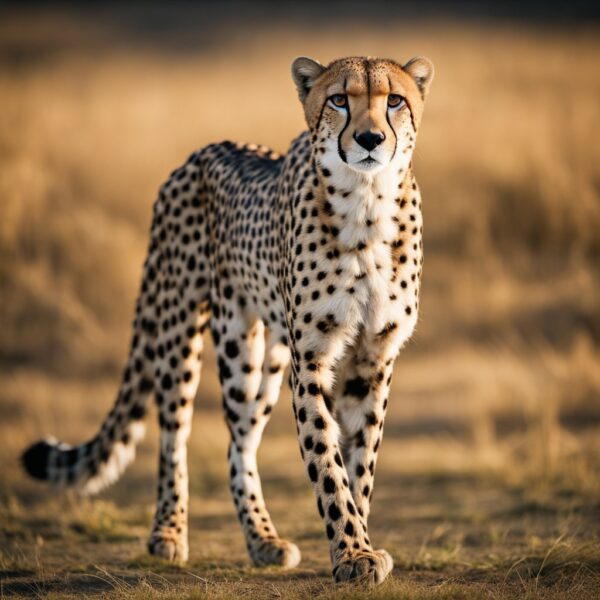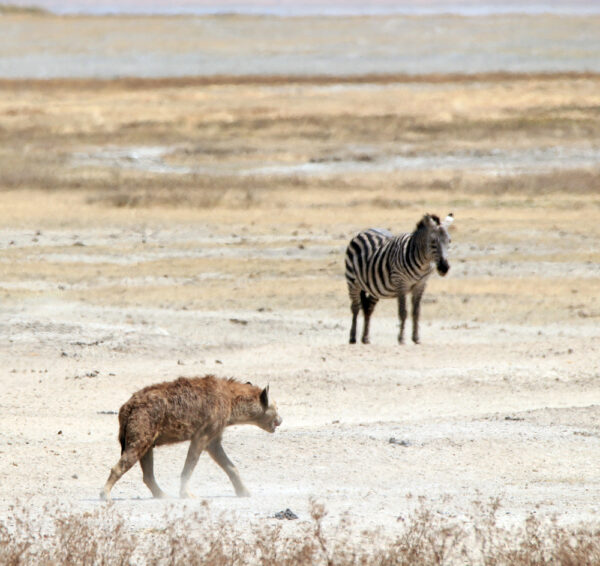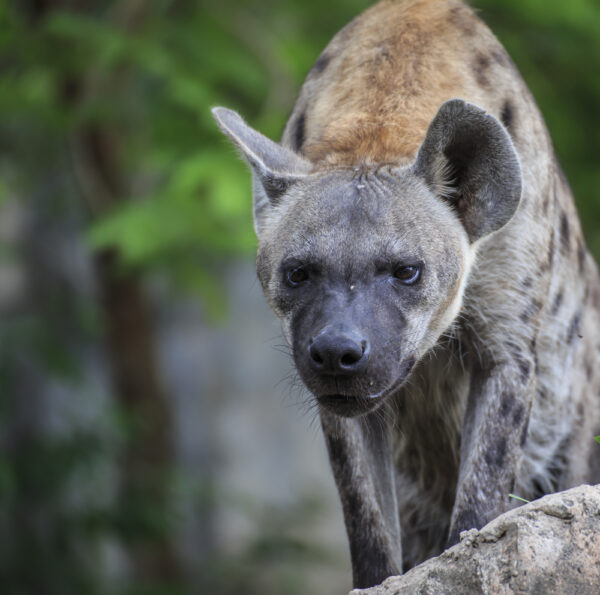
Cheetahs vs Hyenas: Predation and Competition
Cheetah vs hyenas is an example of the competition between two species. In the dynamic ecosystems of the African savanna, particularly in regions like the Serengeti National Park and the Kgalagadi Transfrontier Park, the interactions between species play a critical role in maintaining the balance of the ecosystem. The cheetah, renowned for its unparalleled speed, faces various challenges in these habitats, not least of which is competition with other large predators such as hyenas. Henas, especially spotted hyenas, are formidable competitors known for their strength and strategic group behavior. These two species often come into conflict over resources, showcasing a multitude of survival tactics and behavioral adaptations.
The struggle between cheetahs and hyenas is a clear depiction of the fight for survival in the wild. Cheetahs, built for speed and agility, employ quick hunts to capture their prey before larger predators can intervene. However, they face the threat of kleptoparasitism by hyenas, often losing their hard-earned meals to these robust scavengers. Researchers, including those at institutions like Virginia Tech’s College of Natural Resources and Environment, study these interactions to understand how cheetahs can coexist with and sometimes avoid their more powerful competitors. These insights are pivotal for informing conservation efforts as both species navigate the increasingly pressured landscapes they call home.
Key Takeaways
- The rivalry for resources between cheetahs and hyenas illustrates the complex dynamics of African savanna ecosystems.
- Studies observe how cheetahs adjust their behaviors to mitigate risks from stronger predators including hyenas.
- Conservation and continued research are essential for ensuring the survival of both species within their natural habitats.

Cheetahs vs Hyenas Physical Characteristics
When discussing the physical attributes of cheetahs and hyenas, their unique adaptations and how they use them to survive in the wild are key aspects to consider.
Size and Weight Comparison
Cheetahs (Acinonyx jubatus):
- Size: Length ranges from 110 to 150 cm (excluding tail)
- Weight: 21 to 72 kg
Spotted Hyaenas (Crocuta crocuta):
- Size: Length from head to tail ranges between 95 to 150 cm
- Weight: 40 to 86 kg
This comparative size and weight are crucial for understanding each animal’s role in their environment. While the cheetah is lighter and more streamlined, the hyaena boasts a bulkier build.
Distinguishing Features
Cheetahs:
- Coat: Tan with black spots
- Build: Slender with a small head
- Special: Long tail for balance during high-speed chases
Spotted Hyenas:
- Coat: Sandy, ginger, or grey with spots that may fade with age
- Build: Strong front quarters; hindquarters are visibly lower
- Special: Mane of long hair along the back
These features are not only distinctive in appearance but also relate to each species’ strengths – the cheetah’s agile build for speed and the hyena’s strong forelimbs for endurance and combat.
cheetahs vs hyenas Bite Force and Agility
Cheetahs:
- Bite Force: Weaker relative to size; designed for seizing prey rather than fighting
- Agility: Exceptional, with acceleration up to 60 mph in seconds; capable of quick and sharp turns during the chase
Spotted Hyenas:
- Bite Force: One of the strongest among carnivores; essential for their scavenging habits
- Agility: Less agile than cheetahs but enduring, capable of long pursuits
The bite force of the hyena, significant in both hunting and kleptoparasitic interactions, contrasts with the cheetah’s agility, which is critical for outrunning predators and capturing prey.
Behavioral Traits

Cheetah behaviors have evolved to navigate a landscape shared with more powerful predators like lions and hyenas, focusing on strategies that ensure survival and reproductive success while acknowledging the risks their environment presents.
cheetahs vs hyenas Social Structure and Territories
Cheetahs exhibit a distinct social structure in comparison to hyenas. In terms of territories, males tend to be territorial and may group together in coalitions, often brothers from the same litter, to defend their areas against other males. They mark their territories using urine to ward off intruders and to attract mates. Females, on the other hand, are solitary except when raising cubs and have larger, overlapping home ranges that are not marked or defended.
Hunting and Scavenging Behaviors
When it comes to hunting, cheetahs rely on their exceptional speed and stamina, employing a tactic of stalking to chase and capture prey, which usually consists of smaller antelopes. They hunt primarily during the day to avoid competition with other nocturnal predators. Cheetahs may be subjected to kleptoparasitism, where hyenas and lions steal their kills. This threat has led cheetahs to develop hunting strategies that include high vigilance and swift consumption of prey before it can be taken by larger predators.
- Tactics: Cheetahs utilize the element of surprise and high-speed chases.
- Vigilance: They are constantly aware of their surroundings to prevent theft of their kill.
- Survival Tactics: Consume quickly, avoid fights, and cede kills if challenged.
Reproductive and Rearing Habits
Cheetah females are solely responsible for the rearing of cubs. After a gestation period of around 90 days, a female cheetah may give birth to a litter of 3-5 cubs. She teaches them hunting techniques and the importance of avoidance behavior to ensure their survival in the presence of threats such as lions and hyenas. Cubs learn to navigate their environment’s dangers through intense observational learning, relying on their mother’s behavior as a guide. The mother’s strategy includes selecting den sites with good visibility to safeguard the young and relocating them frequently to avoid detection.
- Offspring Care: Single mothers educate and protect.
- Technique: Instruction in stealth and survival begins early.
- Fear and Dominance: Cubs learn the hierarchy of predators and appropriate responses.

cheetahs vs hyenas Interactions and Competition
In the complex ecosystems of the wild, cheetahs face intense competition from hyenas and lions, impacting their hunting strategies and survivability.
Predator Competition and Coexistence
Cheetahs, known for their incredible speed, have evolved to hunt during the day to avoid direct competition with the more powerful lions and hyenas, which are typically nocturnal predators. Despite the different peak activity times, overlaps do occur, especially around waterholes and prime hunting grounds. Kleptoparasitism is a major issue, with hyenas and lions often stealing kills made by cheetahs. To reduce the risk of such losses and injury from confrontations, cheetahs tend to consume their prey quickly and are careful about territory selection, staying away from areas heavily frequented by these competitors.
Risks and Challenges in the Wild
The main challenges for cheetahs stem from confrontations over kills. Hyenas, which often form large clans, and lions, which may hunt in coalitions, present significant risks. These encounters can result in injury or death for a cheetah. As the smallest of these large carnivores, cheetahs rely on stealth and speed for survival. They tend to avoid scavenging, unlike hyenas, which can both hunt and scavenge, providing them with more food security.
Roles in the Ecosystem
The presence of cheetahs, hyenas, and lions in an ecosystem creates a dynamic balance. Each plays a crucial role in controlling prey populations and ensuring diversity. Competition among them helps regulate their numbers, with cheetahs generally avoiding direct competition due to their specialized role as diurnal hunters targeting smaller and swifter prey. In contrast, hyenas and lions, as more opportunistic feeders and proficient scavengers, exert their dominance over larger territories and prey, often leading to kleptoparasitic interactions with cheetahs.
Conservation Status

The conservation status of cheetahs is a growing concern, with habitat loss and conflict with other large carnivores impacting their populations.
Population Trends
Cheetah populations are considered vulnerable by the IUCN Red List, indicating a high risk of endangerment in the wild. Recent studies suggest that the species has experienced a significant decrease in numbers, with estimates showing that only around 7,100 individuals remain globally. Mothers with cubs face high mortality rates, often as a result of encounters with other larger carnivores, such as lions and hyenas.
Human Impact on Habitats
Human activities have severely fragmented cheetah habitats, leading to genetic isolation and reduced access to prey. This, combined with land conversion for agriculture and human settlements, continues to decrease viable living spaces for cheetahs. In areas of human-wildlife conflict, cheetahs may be killed or removed when perceived as threats to livestock.
Protection Efforts
Conservation efforts for cheetahs include habitat preservation, the creation of protected areas, and working with local communities to mitigate human-wildlife conflicts. Initiatives such as the Cheetah Conservation Fund are actively engaged in research, education, and outreach to promote the coexistence of cheetahs and humans. Anti-poaching measures and legislative enforcement are also crucial in combating the illegal trade of cheetah parts and live animals.
Adaptations and Survival
In the African savannah, cheetahs and hyenas have developed distinct adaptations for survival, revolving around their predation and defense methods, each leveraging their respective strengths in speed and endurance, and strategies in handling prey.
Predation and Defense Techniques
Cheetahs leverage their exceptional speed to outrun predators and catch prey, often reaching up to 60 miles per hour. This speed is pivotal for their survival, as they must quickly down antelope before larger predators can intervene. Meanwhile, hyaenas are equipped with strong jaws and a social structure that allows them to defend kills against larger groups, using intimidation as a key tactic against rivals. Both predators are adept at assessing odds and choosing when to engage or withdraw for safety.
Cheetahs vs hyenas: Speed Endurance
A cheetah’s speed is a clear advantage in the short term, allowing them to capture fleet-footed antelope with brief but intense bursts of speed. Hyenas, conversely, can maintain a steady pace over longer distances, making them efficient at outlasting prey that has already been fatigued, often by other predators. This endurance also benefits them in long-distance interactions with competing scavengers and during confrontations at kills.
Handling Prey and Scavenging Efficiency
After a successful hunt, cheetahs face the challenge of quick prey handling, as the handling time is crucial to avoid confrontation with other predators. Hyenas, often engaging in kleptoparasitism, capitalize on their social structure to efficiently scavenge and occasionally usurp kills from other predators such as cheetahs. This puts pressure on cheetahs to consume or hide their catch rapidly, whereas hyenas can operate more leisurely, utilizing teamwork to guard and dismantle prey, even large buffalo.
Notable Research and Studies
In the dynamic environment of the African savanna, the interactions between cheetahs and hyenas have been thoroughly researched. Anne Hilborn, a notable figure in this field, has contributed significantly through her observations. Empirical data suggest that cheetahs consciously maintain a distance from both hyenas and lions, to avoid confrontation due to the latter’s superior strength and numbers.
Key Findings:
- Avoidance Behavior: Cheetahs often relocate several hundred meters away when in the proximity of hyenas or lions, minimizing potential conflicts.
- Habituation: Studied cheetahs are generally well-adapted to the presence of research vehicles, ensuring reliable data collection.
- Spatial Analysis: The relationship between spotted hyena numbers and lion densities has been quantified, exhibiting significant avoidance patterns by cheetahs.
Research in the Serengeti:
- Kleptoparasitism Incident Rates: Cheetahs modify their behavior when risks from top predators like hyenas increase, indicating an adaptation to avoid losing their kills.
Dynamics in Southern Africa:
- In regions like South Africa and Botswana, particularly the Kalahari, research delves into the advantages cheetahs leverage with their speed versus the endurance of hyenas.
Study Focus:
- Predator and prey handling behavior
- Interactions across different ecological contexts
- Reproductive success in relation to predator avoidance
Conservation Implications:
- Understanding spatial requirements for cheetahs helps in identifying crucial habitats and informing conservation strategies, critical for their survival amidst threats from apex predators.
cheetahs vs hyenas Frequently Asked Questions
In examining the dynamics between cheetahs and hyenas, questions often arise regarding their interactions and conflicts in the wild. These frequently asked questions shed light on the factors that influence their encounters and survival strategies.
What factors determine the outcome of a confrontation between a cheetah and a hyena?
The outcome of a confrontation between a cheetah and a hyena typically depends on multiple factors including the number of individuals involved, the physical condition of the animals, and the presence of cheetah cubs. A solitary cheetah may be more likely to yield its kill to a hyena, especially if outnumbered or facing a particularly aggressive individual.
Who is faster, a cheetah or a hyena, and how does this affect their encounters?
A cheetah is significantly faster than a hyena, being the fastest land animal, capable of reaching speeds up to 75 miles per hour. This speed advantage allows cheetahs to escape from hyenas in direct pursuit and to quickly hunt prey before hyaenas can interfere.
How do the physical attributes of cheetahs and hyenas compare in terms of size and strength?
Hyenas are generally more robust and stronger than cheetahs, with more powerful jaws and a heavier build. In contrast, cheetahs have a slender build and are built for speed, not strength, which puts them at a disadvantage in physical conflicts with hyenas.
In what scenarios might a cheetah or a hyena be victorious in a fight?
A cheetah may successfully defend its kill when it has the element of surprise, is in peak condition, or when the hyena is young or less experienced. Conversely, a hyena often is victorious due to its greater strength, pack support, and tenacity, especially when targeting an isolated or distracted cheetah.
What strategies do cheetahs use to avoid conflict with hyenas?
Cheetahs often employ avoidance tactics to minimize encounters with hyenas, such as hunting at different times of the day and rapidly consuming prey. They may also hide their presence by keeping a low profile when hyenas are nearby and by moving their cubs to safer locations when threatened.
How does the presence of hyenas impact cheetah behavior and survival in the wild?
Hyenas impact cheetah behavior by compelling them to be more vigilant and selective about their hunting grounds and times. Loss of kills to hyenas can affect the cheetah’s ability to nourish themselves and their young, which in turn can influence cheetah survival and reproductive success.